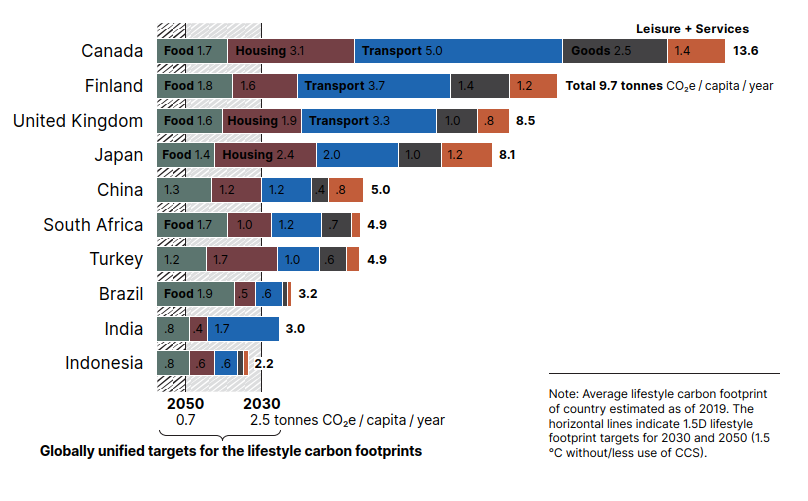Living a sufficiency lifestyle under 1.5 degrees warming

Science clearly says that we must keep global warming under 1.5 degrees warming compared to preindustrial times by 2030, if we want to avoid the collapse of the environment and make life extremely difficult on Earth. What kind of lifestyle changes does that mean for us?
There is plenty of research (here, here, here) and many books that spell it out what that means. Here are some specific guidelines from Lloyd Alter’s book Living the 1.5 Degree Lifestyle which deserve quoting in full:
For what we eat:
If you can, go vegan by eliminating all meat, fish, dairy and eggs.
If (like me) going vegan is too hard, red meat, lamb, and shrimp are off the menu.
Eat less dairy, fish, chicken, and pork; they have a fraction of the footprint of beef, but it’s still three times as big as the footprint of plants.
Shorten the food chain and the cold chain; buy local and seasonal and cook it yourself instead of buying processed or prepared foods.
Learn to love leftovers and throw out as little as possible.
Manage portion sizes and don’t cook more than you need. It is surprising how big the impact of this is. If you do takeout or delivery, walk or bike to pick it up yourself or find out who delivers by bike.
(Figure: Greenhouse gas emissions per 1,000 kilocalories. Greenhouse gas emissions are measured in kilograms of carbon dioxide equivalents (kgCO2eq) per 1,000 kilocalories. This means non-CO2 greenhouse gases are included and weighted by their relative warming impact. Note: Data represents the global average greenhouse gas emissions of food products based on a large meta-analysis of food production covering 38,700 commercially viable farms in 119 countries. Source: Living the 1.5 Degree Lifestyle,Why Individual Climate Action Matters More than Ever)
For how we live:
In new buildings, natural materials with low embodied carbon combined with super-insulation, high-quality windows, and careful sealing to Passive House standards are really the only way we should be building.
In existing buildings, reduce demand as much as possible by sealing, insulating attics and basements and affordable, accessible areas, and meet that reduced demand with air source heat pumps.
In terms of your carbon footprint, apartments are better than duplexes or townhouses, which are better than single-family houses.
15-minute cities, transit-oriented developments, walkable communities, bicycle lane networks all contribute to lower-carbon living.
Check out what you can walk to in 30 minutes, not an unusual time for a commute. Even in the suburbs, it will include a surprising variety of places to shop. Try that instead of driving.
Electrify everything.
For how we move (this is for people who already exceed the recommended footprint):
Get out of your car; it is the biggest single factor in most people’s footprints. Note I didn’t say get rid of your car; we still have one for longer trips and occasional use. But use it as little as possible.
Choose where you live carefully; it is the single biggest influence on how much you drive. Where you live defines how you get around.
In order of impact: walk, bike, e-bike; and many now are looking at e-cargobikes.
Fly as little as possible.
For why we buy I will add my own guidelines:
The one-year test: Imagine the thing you want to buy one year into the future. If you are not sure if you are still using it, don’t buy it.
Don’t buy clothes for fashion. Buy for need. Buy very little. Repair and repurpose what you have.
Think about all the components of the thing you are buying. If it has too much upfront carbon in its components, don’t buy it.
Keep appliances and gadgets until they break. Then repair. Don’t buy for fashion.
Really, really understand the difference between needs and wants. Needs keep you alive and maintain your wellbeing. Wants do not keep you alive, they are just psychological fads. Transportation is a need. A personal car is a want where public transportation is available.
Block, boycott, ignore all advertising both in real life and on line.
The required individual carbon footprint to keep warming under 1.5 degrees Celsius is 2.5 tonnes of carbon emissions and equivalent chemicals per person per year by 2030, and 0.7 tonnes by 2050. Six years ago Canada had an average of 13.6 tonnes. Two years ago, instead of going down, the average increased to 14.9 tonnes (another source here with data is based on territorial emissions, which do not account for emissions embedded in traded goods)
Is it enough to stop buying what they are selling?
Forty years ago, smoking was was socially acceptable and happened everywhere. The top-down response was governments applying education, regulation, and taxes. Bottom-up pressure increased with social shaming and stigmatizing. Instead of signalling virtue we signalled vice. It worked, but it was not easy for many individuals. Ask almost anyone who was addicted and has given up smoking, and they will tell you that it was the hardest thing they have ever done. Changing lifestyles is possible, but it can be very difficult and it does not happen if we do not talk about the issues head-on.
And here is difference between sufficiency and degrowth. Sufficiency tends to be about having just enough stuff for basic, decent, personal living. Degrowth looks at both lifestyles and the entire economic system.
Degrowth is an expansion of social agency and wellbeing for all humans, within the limits of Earth, through a selective reduction of production and consumption to lighten our ecological footprint, planned democratically in the spirit of social justice. See a comprehensive list of definitions here.
Degrowth reminds us that individual lifestyles and even collective lifestyles within family units, or local community spaces do not exist in social isolation. All humans are attached through the environment, because all humans ARE the environment.
Banning tobacco was both a bottom-up and a top-down strategy. But it’s one thing to stop buying consumer goods and another for a government to stop buying guns and bombs, for industrial agriculture to stop buying ammonia as fertilizer, for construction companies to stop buying concrete, for hospitals to stop buying single use plastics.
We will never reach the target for emissions if we just focus on the demand-side alone, which is what we buy. The supply-side, which is the production side, must also drastically change if we want to meet the targets.
Changing our economic habits is also a matter of culture. The abolition of slavery, universal suffrage, marriage equality, civil rights, all had many dimensions from culture, to politics, to economics. They all needed tough conversations about the values we hold as a society. It is clear that the average lifestyle in the rich countries is destroying the environment and may lead to the collapse of life on Earth.
Of course, lifestyles must update voluntarily. Many humans are already doing it, many want to change but are trapped in bad habits or bad circumstances, some deny the reality altogether, some accept the reality and think it’s too late to do anything about, some are purely egotistic or sociopaths and want extravagances while the world burns around them.
I don’t want to be in the position of telling people how to live their lives. However, just by saying these things, some humans may feel like they are being told what to do. This is why convincing people one-on-one almost never works, and perhaps these kinds of indirect conversations might be more palatable and easier to digest.
Did Jesus tell people what to do by dictating orders and enforcing behaviours with promises and threats for non-compliance? People respond to very different motivators, and imitation is a powerful one. People do not want to be excluded from their group. An external force, such as a strong idea, or sometimes the threat of violence, may be the triggering factor. The collapse of the environment and civilisation should be such a trigger, yet many pretend they don’t see it. Like in the movie Don’t Look Up.
Changing lifestyles may be about group-think. Seeing that your neighbour does it first, the rest of your family does it first, that might influence you to do it. But in some cases, it may have the opposite effect. You may want to do the opposite of your neighbour or family, if you just don’t like them. So maybe, just maybe, social pressure is more powerful than in-group thinking. To get to social pressure, these facts should be known by as many people as possible.
Yet, some of us do not need to follow the imitation path. Some of us are ready to do it, can do it, wish to do it, before everybody else. This is history repeating over and over again, with those suffering, the oppressed minorities, the oppressed majorities building towards a critical point of convergence. Half of humanity owns as much wealth as a bunch of billionaires. What stops that many people to take back what was stolen from them, which is their future?
If you can decrease your footprint under 2.5 tonnes that’s great! Do your best. If you notice that while you are doing your best and you are still not reaching the target, then the problem is not you, the problem is the system. Do not stop doing what you are doing, but aim your anger and frustration at the system. Demand the end of capitalism! Demand an Economy for Life.




There is a miss-conception that everything has to change first so we change. We cannot expect systematic change with personal change. We do have to show that another world is indeed possible today, not as a consumers, but as committed citizens.